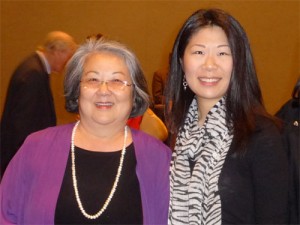Looking Back – Lived Experiences and Family History
As a sort-of Sansei (3rd generation) and also as an immigrant born in Japan to Nisei parents (2nd generation, Japanese- American and Japanese-Canadian), who were stuck in Japan during the war years because the Chinese Exclusion Act would not let them stay in either of their birth countries after their marriage in Washington State, I always felt like I never fit in with the Asian American community, when I arrived as a 12 year old, in 1958.
All the JAs (Japanese Americans), including my Mother’s family were busy assimilating and not talking about the war years at all. I thought my Mother’s family in California and the others, especially my peers, were odd because no one spoke Japanese or seemed proud of their heritage. The JAs at school and church were very clique-ish and they thought it odd that for an FOB (fresh off the boat), I didn’t have a funny Japanese accent. I fit in better with the Caucasians and for that I was also ostracized because the JAs thought I was snobby mixing with the white kids. I was on the cusp of being a teen, away from my homeland with a mother going through a divorce, in 1958.
I didn’t know abut the camps and what they had done to our community. As a 7th grader in Alameda, there was nothing in the history books. I didn’t know what it was like to grow up as a “minority” and never experienced racism until I came to the United States.
Post war Japan, I grew up playing in bomb shelters and my friends and I making fun of the GIs, when we saw them – they were the minority.
All that changed with the Vietnam War, my college years in the 60s at UC Berkeley, and the political and social awakening of all the disenfranchised communities. The redress movement began and we all learned about the concentration camps that were not in Germany but here in the US. Some family members began slowly to talk about it. My uncles talked more with pride and bitterness about their military experiences, and my aunts about the heat, the lack of privacy and the externals of their experiences, but, never about their true emotions or what it did to them individually and collectively as a family. It came out in different dysfunctional ways – my uncles seemed weaker than my aunts – they had alcohol and abuse problems. The aunts held their families together and after raising their kids and getting them through universities, went to get their own degrees.
Reflections of a Zen Buddhist:
“That happiness endures which comes from the grinding
together of anguish and ecstasy, and from the intensity
of the grinding. That knowledge is true which comes
from searching into the doubts and beliefs and from
the depth of the searching”.
In Colorado
When I found out my Aunt Aiko was at Amache, I asked her about it and she said she has no nostalgic memories. I don’t think anyone does but I wanted to get some information.
The historian and former internee, Bob Fuchigami, our guide at Amache was able to tell me exactly what block and room she was in. Only the foundations are left – they are in the process of re-acquiring several of the barracks that exist and the hexagonal water tower from near by.
It was truly an emotional visit and as our bus traveled alongside the railroad tracks that brought everyone to the camp, I was quite overcome, and Bob reminded us that unlike us, the shades on the trains were drawn so they could not see where they were going. I can’t describe what those plains in Southeastern Colorado is like – it was a High Wind Advisory day and the sand and grit was truly awful and we were in it for only an hour, and it was only 90 degrees, not 110. My Aunt and her husband were there for a year only, others, for much longer.
Seeing the little museum that John Hopper, the high school teacher created with his students in 1993 and maintain- smaller than my living room – full of items discovered or given to them – tea cups and photographs, the neat cemetery they created around the gravestones of those who died there- the trees they planted in that arid countryside that they water, regularly The fights Mr. Hopper has had to keep it going against those elements in town who want to forget it – a teacher with 65 students making such a difference and contribution, truly humbled me. On several of the pictures I took of the two monuments, you can see some damage – those are gun shot holes and look recent.
Telling the story of my grandparents immigration and of raising their children in Alameda with a laundry business and nine of their ten children and themselves, first sent to the Tanforan Racetracks for “processing” – sleeping in stables and then sent to the different camps – Amache (Granada) Colorado, – Poston, Arizona – and Topaz, Utah, and lighting a candle for them, all the pain, hurt, anger and indignities they suffered, I felt at that moment and I wanted to scream and lash out. Hearing others crying, lighting their candles and telling their stories, made me realize and wish that my Mother was alive to see this and know that her pain of being isolated from her family and being in country that was not home to her during the war years, the indignities she suffered because she wasn’t Japanese enough, and her deprivations, while all painful to her, she at least had her physical freedom and lived in her own home with her husband’s family and not separated from her children.
Going to the site of the Sand Creek Massacre was also quite overwhelming and we participated in a healing ceremony there as well. Looking out at the vast plains, hearing the Elders tell the stories of the massacre, still as fresh to them as yesterday, with the pain and tears in their voices and eyes, I felt honored to be a witness. This cannot be forgotten – most people in this country don’t even know of it. Our leaders say “never again” and yet it is happening still. In Arizona and Austin, MN and elsewhere in this country, there are people ready to let it happen again to anyone who is not white enough.

